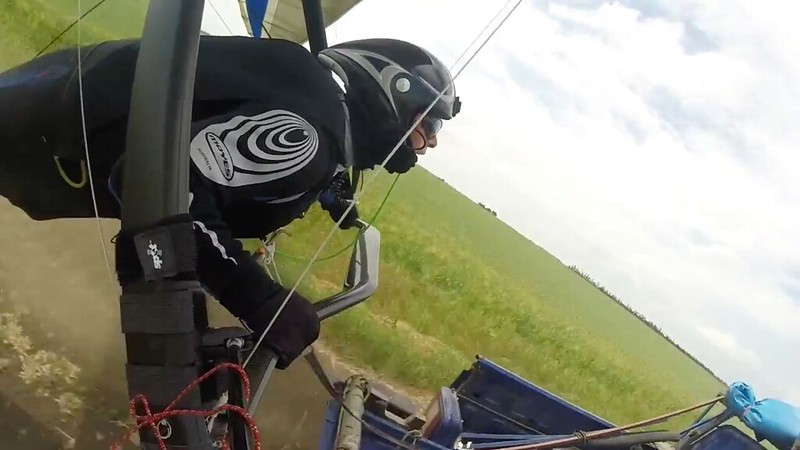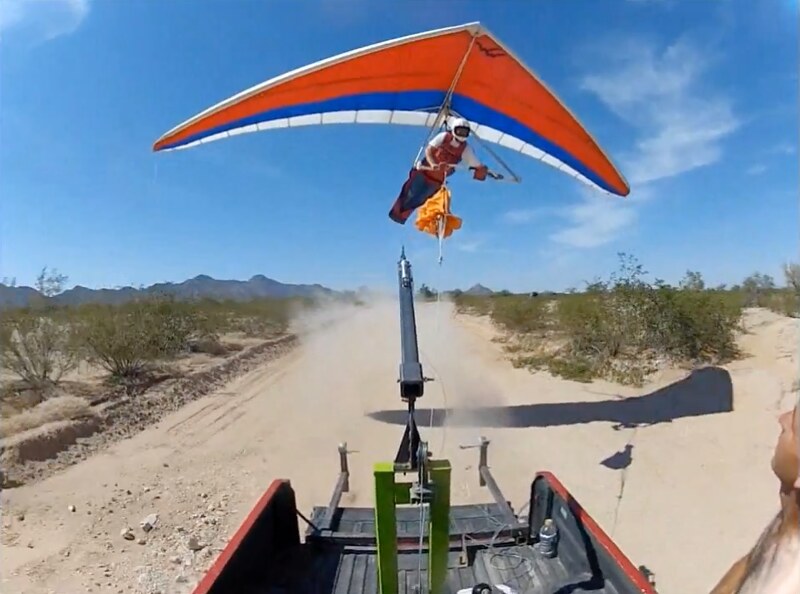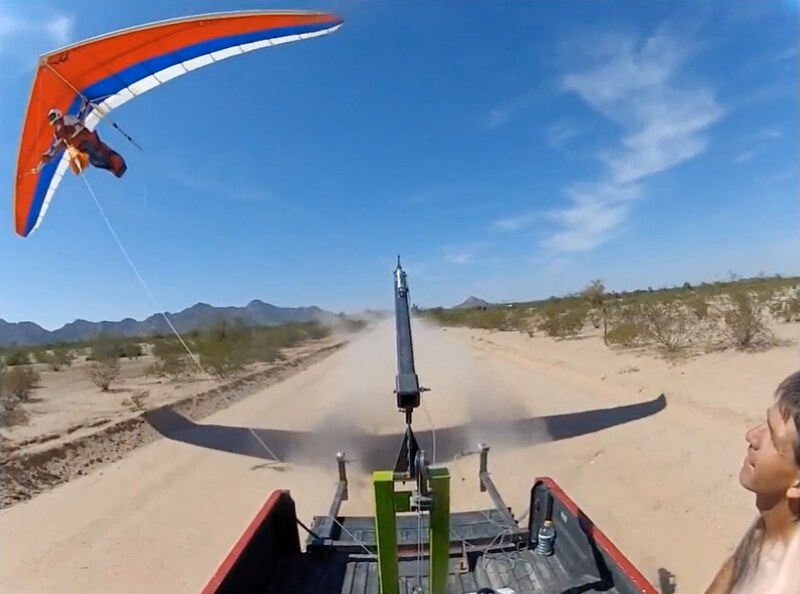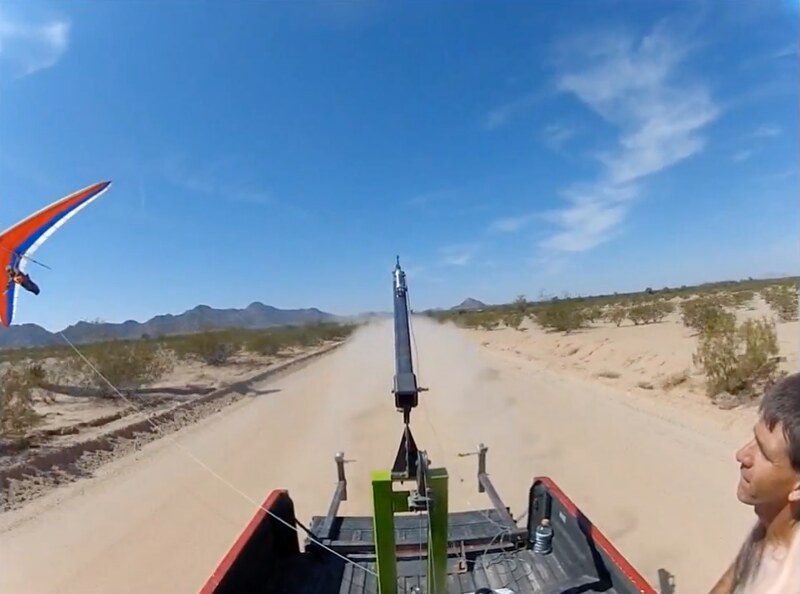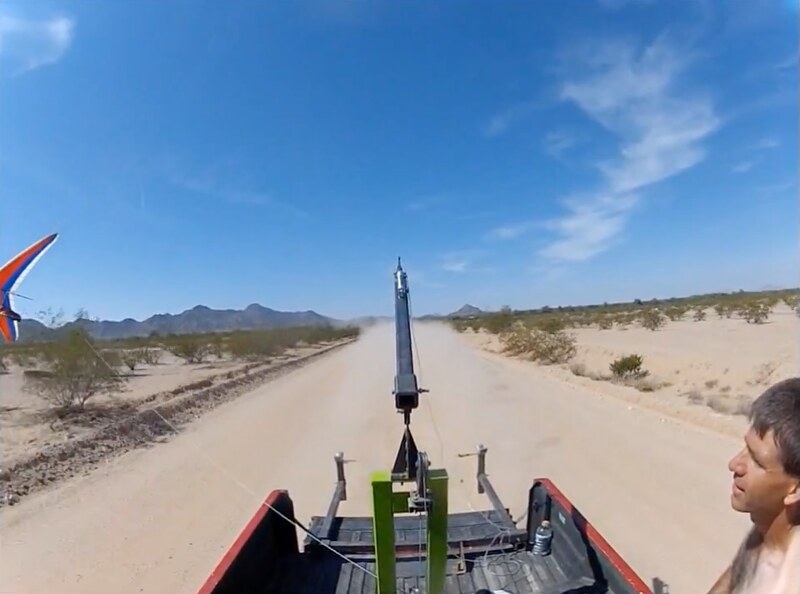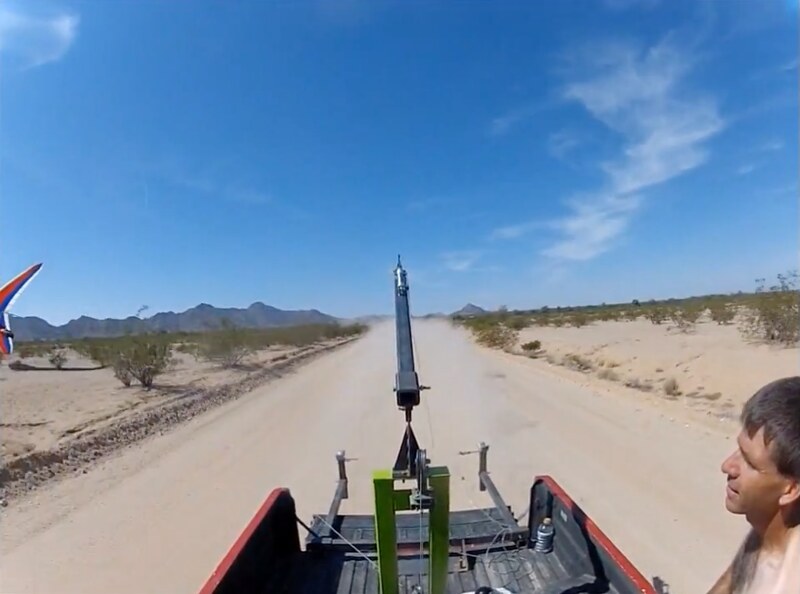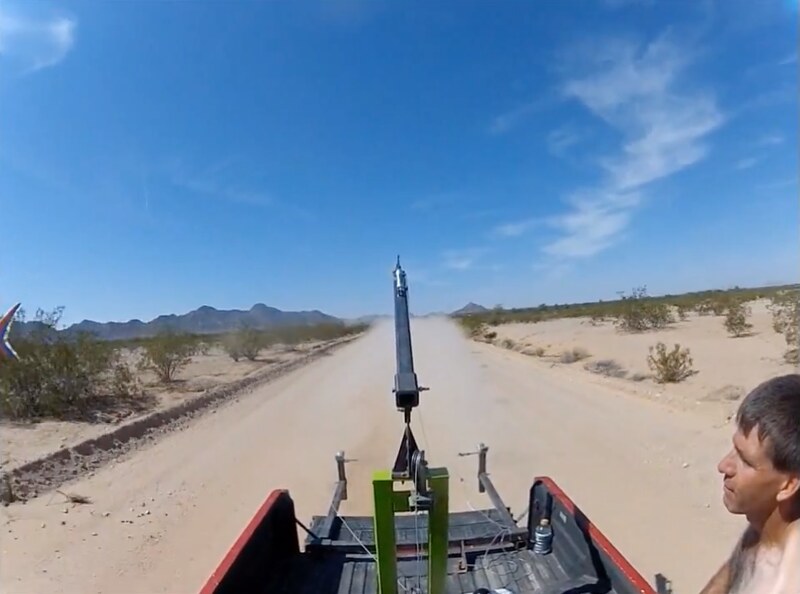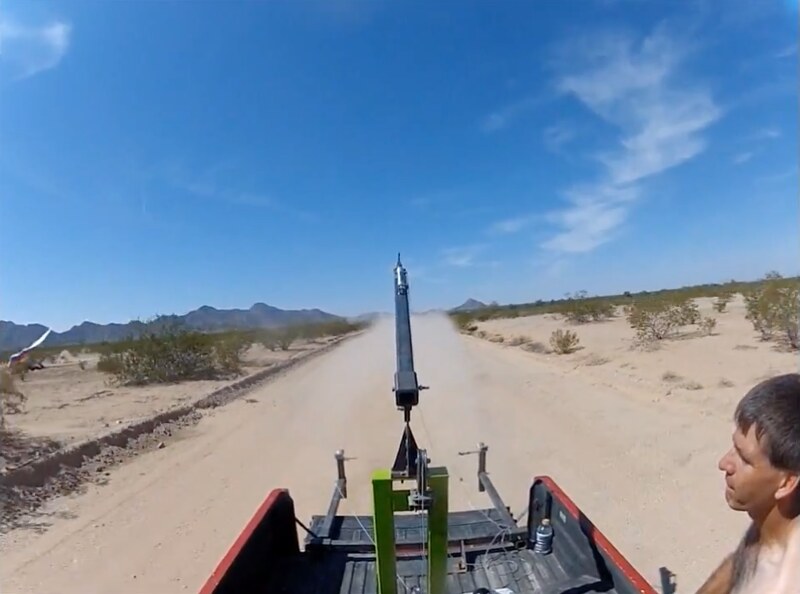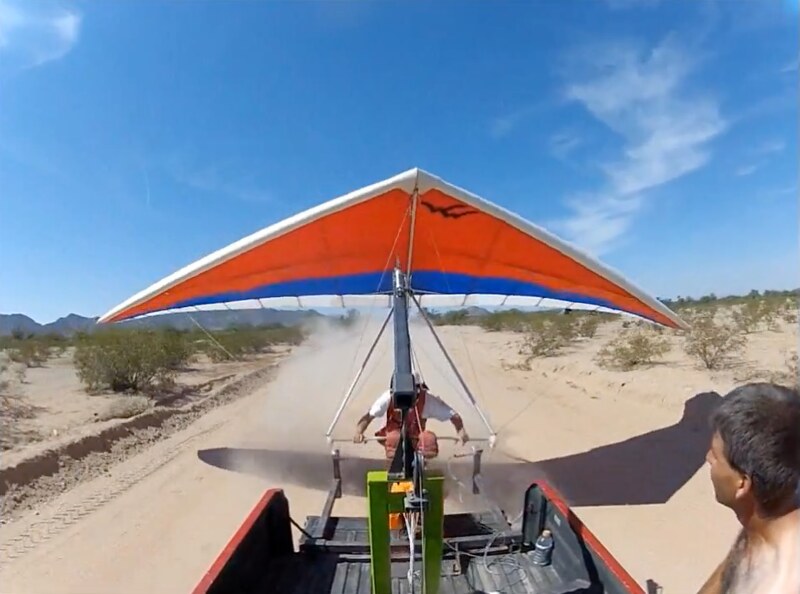Donnell Hewett - 1981/10-07
WEAK LINK
Every tension limiting device discussed up to now consists of mechanical components, has a limited range, or relies upon human operation. Every one of these tension limiting devices is subject to failure. Please correct me if I am wrong, but it is also my understanding that there are a large number of tow pilots today who are depending upon smooth air, rope stretch, boat speed, mechanical devices, and ground crews to provide the tension limitation control for their flights. Well, in the author's opinion that is just not good enough. Skyting requires the use of an infallible weak link to place an absolute upper limit to the towline tension in the unlikely event that everything else fails.
Now I've heard the argument that "Weak links always break at the worst possible time, when the glider is climbing hard in a near stall situation," and that "More people have been injured because of a weak link than saved by one." Well, I for one have been saved by a weak link and would not even consider towing without one. I want to know without a doubt (1) when I am pushing too hard, and (2) what will break when I push too hard, and (3) that no other damage need result because I push too hard.
Furthermore, I will not use a mechanical weak link no matter how elaborate or expensive because there is always the possibility that it may fail to operate properly. In skyting we use a simple and inexpensive strand of nylon fishing line which breaks at the desired tension limit. There is no possible way for it to jam and fail to release when the maximum tension is exceeded. Sure, it may get weaker through aging or wear and break too soon, but it cannot get stronger and fail to break. If it does break too soon, so what? We simply replace it with a fresh one.
A properly designed weak link must be strong enough to permit a good rate of climb without breaking, and it must be weak enough to break before the glider gets out of control, stalls, or collapses. Since our glider flies level with a 50 pound pull, climbs at about 500 fpm with a 130 pound pull, and retains sufficient control to prevent stalling if a weak link breaks at 200 pounds pull, we selected that value. Of course, a pilot could deliberately produce a stalled break at 200 lbs, just as he can stall a glider in free flight. But if he is trying to limit his climb rate and the forces exceed the break limit, the glider simply drops its nose to the free flight attitude and continues flying. If the weak link breaks (or should the towline break) at less than the 200 pound value, the effect is even less dramatic and controlled flight is still present.
...
Although we suspect that the same weak link would work well with other gliders, we have not had the opportunity to run tests on other gliders to varify this suspicion. Until such tests can be run, we strongly recommend that considerable caution be exercised in determining the correct weak link for any other glider. One should start with a line that definitely breaks too soon, gradually increasing the strength until a point is reached where the glider is able to climb at a good rate without breaking the weak link, but where no stall occurs when the weak link does break.
Obviously, more work needs to be done in this area, but even so, we have found our current system to be quite satisfactory and able to provide the necessary tension limiting and regulation needed for safe and enjoyable flight under tow. Our next article will discuss various methods of attaching the towline to the glider and why the skyting method is to be preferred.
Every tension limiting device discussed up to now consists of mechanical components, has a limited range, or relies upon human operation.
Hang gliders consist of mechanical components, have a limited ranges, and rely upon human operation. You're supposed to understand all that before you clip into one for the first time. Ditto for everything else we humans have ever used to get airborne from Otto Lilienthal through the SR-71, Apollo 17, the Space Shuttle. What's your point? Those of us who BELONG in recreational aviation understand and are totally fine with the complexities, limitations, capabilities and would rather not have incompetent tow drivers, loops of fishing line, Birrenators making our critical decisions for us. And if you ever did any flying worth hearing about I never heard about it. And it's hard for me to even imagine that you did.
Skyting requires the use of an infallible weak link to place an absolute upper limit to the towline tension in the unlikely event that everything else fails.
Super. In free flight a defective sidewire places an absolute upper limit to positive G loading in the unlikely event that everything else fails to succeed. (Otherwise it's likely to be an outboard leading edge or cross spar.) And there've been people who've been able to walk away from those successes in a lot better shape than a lot of the beneficiaries of Infallible Weak Link interventions.
I want to know without a doubt (1) when I am pushing too hard, and (2) what will break when I push too hard, and (3) that no other damage need result because I push too hard.
So how the fuck do you know without a doubt when you're pushing too hard and what will and won’t break when you push too hard in free flight? I never had the slightest problem with any of these concepts in any flavor of flying from Day One, Flight One on - and that included frame only towing before any of your stuff was submitted for publication anywhere.
- In free flight if you push too hard things start getting real quiet. And if you don't start getting your shit back together sometime within the next 1.2 seconds you cease being a pilot for at least the immediate future.
- On tow as you start pushing too hard your rate of climb is degraded. And there's NOBODY who does that 'cause the feedback is pretty immediate and unmistakable. It's like free flying best glide - it's pretty intuitive and people tend to do it pretty well - 'specially when they're low trying to make a field.
How come you don't seem to have a problem knowing without a doubt when you're pulling too hard? Is it because you've always got the ground coming up to serve as a reference whereas with pushing there's very rarely a cloud in position to give you the requisite perspective?
There is absolutely NOTHING in this crap about the glider being the least bit out of the pilot's and/or driver's control. It's ENTIRELY about the tow being TOTALLY under control but under the control of a "pilot" with no fuckin' clue as to what's supposed to be going on. None of us has ever seen anything like this in real life. And you're coming into this sport with a sailplane ticket.
But if he is trying to limit his climb rate and the forces exceed the break limit, the glider simply drops its nose to the free flight attitude and continues flying.
- Yeah. An instantaneous loss of two hundred pounds of thrust, the glider SIMPLY drops its nose (in response to the STALL) to the free flight attitude, (recovers from the STALL,) and (THEN) resumes - sorry - CONTINUES flying. And obviously there's no set of circumstances that have ever in the entire world history of fixed wing aviation manifested itself such that the ground will get in the way before this process has been successfully and safely completed.
- The only time the PILOT functions as a PILOT is when he's TRYING to limit his climb rate. Then after he's failed at this Day One, Flight One fundamental function he's a passenger as the glider takes over in simply drops its nose and continues flying with no input whatsoever from the PILOT.
- But we're not talking about your Infallible Weak Link breaking when you're trying to limit your climb rate (defeat the whole fucking purpose of the tow). We're talking about it breaking when you're doing the polar opposite. And that WILL translate to a whipstall. And you better be fuckin' high when that happens.
- 130 pounds. Yours Truly, HPAT 158, 914 Dragonfly, steady normal climb - 125. You add more tension for surface tow as soon as you need to start factoring in a tow angle. It is IMPOSSIBLE to blow 200 hundred pounds in those circumstances. If you're blowing a 200 pound weak link in those vanilla circumstances it's degraded 35 percent - way more, actually, 'cause you're trying to LIMIT your climb rate. Otherwise something else needs to have been going on. And assuming the assholes on the ends are performing halfway competently that's gonna be a powerful thermal and all bets are gonna be OFF as to what the consequences will be - just like they will be when the ends AREN'T performing competently.
And the deck's already stacked for an unpleasant outcome 'cause nobody with a shred of competency would be buying into this rot so there's no competency at either end.
- How is it that you're so highly proficient at limiting your climb rate but so totally fucking clueless in the pushing too hard department?
Although we suspect that the same weak link would work well with other gliders, we...
We who? How come you never give a punctuation mark's worth of credit to one single other member of the Skyting Theory development team?
...have not had the opportunity to run tests on other gliders to varify this suspicion.
- That's OK, Donnell. You haven't had the opportunity to run tests on ANY glider to varify any of this total rot.
- You'd be astounded to know just how well a single loop of 130 pound Greenspot Cortland braided Dacron trolling line worked for any solo glider you wanted to name. For decades it was the only way it was possible to even make it to launch position on AT. It wasn't until late morning on 2011/08/11 that it was determined that a double loop of the same precision fishing line would work equally well (as long as you told the tug pilot you were doing that.)
Until such tests can be run, we strongly recommend that considerable caution be exercised in determining the correct weak link for any other glider.
Why? You say:
Skyting requires the use of an infallible weak link to place an absolute upper limit to the towline tension in the unlikely event that everything else fails.
Everything else needs to fail before the weak link - like the parachute or helmet - can come into play. So why should it matter if it's three times the sweet spot rating?
Furthermore... In REAL aviation weak links strengths are directly proportional to glider load capacity. If you use a 750 pound weak link for a 500 pound glider you use a 1125 pound weak link for a 750 pound glider. In this stuff you're pulling outta your ass the arithmetic would be the same. That's what you use math and science for - to tell you what you need to do in the engineering.
One should start with a line that definitely breaks too soon...
Fuck yeah. Nobody ever got scratched as a consequence of an extra safe weak link. The recovery time drops to near total insignificance.
...gradually increasing the strength until a point is reached where the glider is able to climb at a good rate without breaking the weak link, but where no stall occurs when the weak link does break.
The way we did for our own glider. It just simply dropped its nose to the free flight attitude and continued flying - no hint whatsoever of a stall. And make sure you do this in glassy smooth air - 'specially when going through the definitely-too-soon phase - the way we did. Otherwise your data tends to get significantly fucked up by all the variable issues.
Obviously, more work needs to be done in this area...
Obviously. So where can we go in your next five years worth of Skyting newsletter publications to find the reports and results? Where can we go in hang and/or para gliding in the next 39 plus years to date for info on further testing and results to help us maybe tweak things a bit better?
http://groups.yahoo.com/group/skysailingtowing/message/6686
Weaklinks
Donnell Hewett - 2008/10/14 00:49:34 UTC
6686
In my opinion, the sole purpose of a weak link is "to allow the aircraft to recover safely when the weak link does break".
Still just pulling whatever you feel like outta your ass - presenting your personal opinion as indisputable scientific fact.
...but even so, we have found our current system to be quite satisfactory and able to provide the necessary tension limiting and regulation needed for safe and enjoyable flight under tow.
Yeah Donnell... Ya lower your standards enough...
